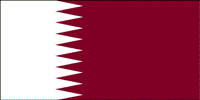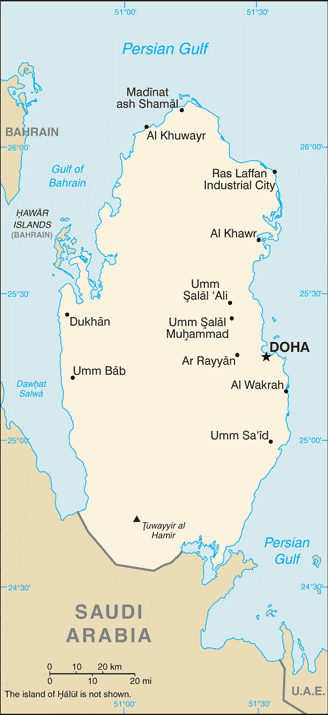Topics Covered
Welcome to Qatar
Overview of Resources
Metals
Industrial Minerals
Fossil Fuels
Investment
Sources
Welcome to Qatar
Qatar is a part of the Middle East countries bordering the Persian Gulf and Saudi Arabia. The total area of the country is 11,586 km2, and it has a population of 1,951,591 as of July 2012. The country experiences arid climate.
 |
The national flag of Qatar.
Image Credit: CIA Factbook. |
Qatar has managed to maintain a stable government despite a bloodless coup in 1995. It has also enjoyed peace and harmony in the recent years due to its immense oil wealth. The country boasts one of the lowest unemployment rates in the world.
Qatar’s most significant natural resources are petroleum and natural gas. The revenues from oil and natural gas in 2007 helped it achieve the world’s highest per capita income. The country recovered quickly from the global financial crisis of 2008-2009 due to the increased oil prices in 2010. The GDP of Qatar in 2011 was $184.3 billion. The fast growth rate in 2011 growth was attributed to the government’s investment in expanding its gas sector.
The recent economic policy of Qatar is focused on developing other mineral and metal sectors and attracting both local and foreign investments into these areas.
Overview of Resources
Qatar’s oil and gas together account for more than 50% of GDP, 85% of its export income, and 70% of government revenues. It is estimated that the country’s oil reserves amount to more than 25 billion bbl and is likely to last for 57 years at the current output levels. Likewise, its natural gas reserves amount to more than a trillion m3, making it the third largest in the world.

The map of Qatar. Image Credit: CIA Factbook
Metals
A joint venture between Qatar Petroleum and Norsk Hydro operated the Qatalum’s aluminum smelter in 2011. This $5.7 billion plant was designed to produce 585,000 Mt/yr of aluminum.
In 2010, Qasco exported a 60,000-t of direct-reduced iron (DRI) to JFE Steel Corp. of Japan. Similarly, Qatar Steel exported DRI to Saudi Arabia, China, India, Iran, Kuwait, Egypt, the Republic of Korea, Spain, and UAE.
In the same year, Qasco signed an agreement with Samarco Mineração S.A. of Brazil to export iron ore pellets used in DRI production for 6 years.
Industrial Minerals
The first helium production plant in Qatar was designed with a production capacity of 20 million m3/yr of helium. Qatar Helium 2, the country’s second helium production plant, will begin operation in 2013. It has the capacity to produce 38 million m3/yr. The combined production of the two plants will amount to one-third of the current global demand for helium.
Qafco, a joint venture between Industries Qatar with 75% interest and Yara Netherland BV of the Netherlands with 25% interest, is the leading producer of nitrogen fertilizer in the Middle East. In 2010, Qafco planned to expand its production capacity by 3,500 t/d of ammonia and 3,500 t/d of urea. The company exported ammonia and urea to more than 35 countries including 57% of ammonia to India.
Qatar Melamine Co. was jointly owned by Qafco with 60% interest and Qatar Intermediate Industries Holding Co. Ltd. with 40% interest. Melamine production began at its new 60,000 t/yr-capacity plant in Mesaieed Industrial City in 2010.
Fossil Fuels
Qatar’s natural gas production averaged 11.2 million ft3/d in 2010. Further increase to about 15.9 million ft3/d is expected this year. The country’s natural gas was mainly produced from the offshore North field, which is recognized as the world’s largest non-associated natural gas field. The reserves at this field amount to about 99% of the total gas reserves in Qatar.
According to 2010 estimates, Qatar is known to be the world’s leading producer of gas-to-liquids (GTL). Oryx GTL, a joint venture between Qatar Petroleum and Sasol Ltd. of South Africa, produced 24,000 bbl/d of diesel, 9,000 bbl/d of naphtha and 1,000 bbl/d of LPG.
In 2010, Qatar’s petroleum sector produced crude liquid hydrocarbons such as crude oil, natural gas liquids, and condensates. The average production was 1.57 million bbl/d in 2010. This is expected to increase to 1.90 million bbl/d this year.
Qatar’s only onshore oilfield is the Dukhan oilfield, which produced about 250,000 bbl/d of crude oil and condensates in 2010. The offshore oilfields in Qatar are listed below:
- Al Karkara oilfield
- Al Khalij oilfield
- Al Rayyan oilfield
- Al Shaheen oilfield
- Bul Hanine oilfield
- Idd Al Shargi South Dome oilfield
- Idd Al Shargi North Dome oilfield
- Maydan Mahzam oilfield
Investment
With the 2022 FIFA World Cup in mind, Qatar’s government plans to spend $225 billion between the years 2011 to 2016 to upgrade its infrastructure. This will indirectly aid the mining sector with better transport and power facilities. The government has also invested a lot in the non-fuel sector and expects it to contribute about 80% to economic growth by 2015.
Qatar has opened doors for both private and foreign investments, which has increased the number of expansion projects that are currently underway especially in the helium, GTL, iron and steel, and nitrogen fertilizer fields. Qatar’s mining sector thus has a promising future.
Disclaimer: The Author of this article does not imply any investment recommendation and some content is speculative in nature. The Author is not affiliated in any way with any companies mentioned and all statistical information is publically available.
Sources